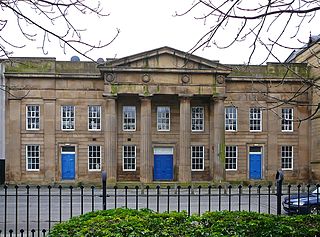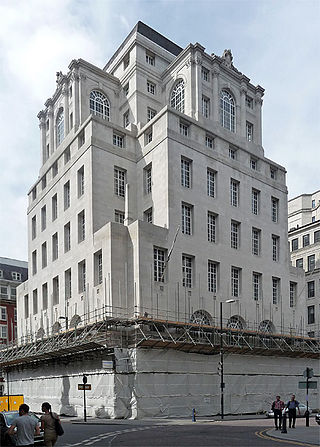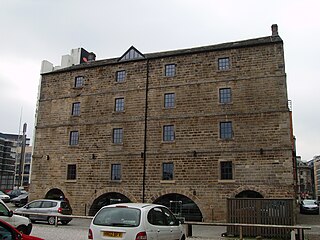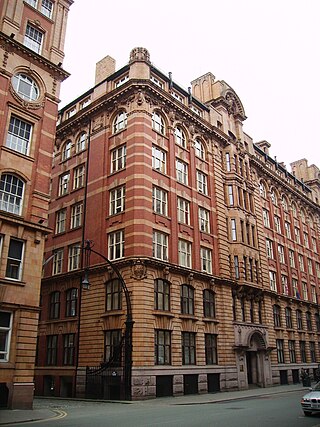
Chorlton-on-Medlock is an inner city area of Manchester, England.

100 King Street, formerly the Midland Bank, is a former bank premises on King Street in Manchester, England. It was designed by Sir Edwin Lutyens in 1928 and constructed in 1933–35. It is Lutyens' major work in Manchester and was designated a Grade II* listed building in 1974.

Ardwick is a district of Manchester, England, one mile south-east of the city centre. The population at the 2011 census was 19,250.

Bridgewater House is a packing and shipping warehouse at 58–60 Whitworth Street, Manchester, England. It is recorded in the National Heritage List for England as a designated Grade II listed building.

The University Dental Hospital of Manchester is a dental facility in Manchester, England. It is managed by Manchester University NHS Foundation Trust.

The Memorial Hall in Albert Square, Manchester, England, was constructed in 1863–1866 by Thomas Worthington. It was built to commemorate the bicentennial anniversary of the 1662 Act of Uniformity. One of the best examples of Venetian Gothic revival in the city, the hall is a Grade II* listed building.

Dale Street Warehouse is an early 19th century warehouse in the Piccadilly Basin area of Manchester city centre, England. It is a Grade II* listed building as of 10 November 1972. It is the earliest surviving canal warehouse in the city. The building is dated 1806 with the initials "WC" on the datestone indicating that it was designed by William Crosley, an engineer who worked with William Jessop on the inner-Manchester canal system.

Minshull Street Crown Court is a complex of court buildings on Minshull Street in Manchester, England. The court was designated a Grade II* listed building on 2 October 1974. It is one of two Crown Courts in Manchester, the other being Manchester Crown Court.

Brookfield Unitarian Church, Gorton, Manchester, England is a Victorian Gothic church. It is a member of the General Assembly of Unitarian and Free Christian Churches, the umbrella body for British Unitarians.

Lancaster House in Whitworth Street, Manchester, England, is a former packing and shipping warehouse built between 1905 and 1910 for Lloyd's Packing Warehouses Limited, which had, by merger, become the dominant commercial packing company in early 20th century Manchester. It is in the favoured Edwardian Baroque style and constructed with a steel frame clad with granite at the base and Accrington red brick and orange terracotta. The back of the building is plain red brick. It is a Grade II* listed building as of 3 October 1974.

India House in Whitworth Street, Manchester, England, is a packing and shipping warehouse built in 1906 for Lloyd's Packing Warehouses Limited, which had, by merger, become the dominant commercial packing company in early-20th century Manchester. It is in the favoured Edwardian Baroque style and is steel-framed, with cladding of buff terracotta and red brick with buff terracotta dressings. It is a Grade II* listed building as of 3 October 1974.

The Tootal, Broadhurst and Lee Building at No. 56 Oxford Street, in Manchester, England, is a late Victorian warehouse and office block built in a neo-Baroque style for Tootal Broadhurst Lee, a firm of textile manufacturers.
Joseph Stretch Crowther was an English architect who practised in Manchester. His buildings are mainly located in Manchester, Cheshire and Cumbria.

The Redfern Building is a Grade-II listed building which was completed in 1936 in Manchester, England. The building is situated on Dantzic Street and meets the junction of Mayes Street and Hanover Street. Redfern was originally built for office and warehouse use.
Manchester is a city in Northwest England. The M11 postcode area of the city includes the suburb of Clayton. This postcode area contains 15 listed buildings that are recorded in the National Heritage List for England. Of these, two are listed at Grade II*, the middle of the three grades, and the others are at Grade II, the lowest grade. Most of the listed buildings in the area are associated with the Ashton Canal, which runs through it; these consists of locks, bridges, and a lock keeper's cottage. The other listed buildings are a former manor house, a bridge in the grounds of the manor house, two churches, and a school.
Manchester is a city in Northwest England. The M12 postcode area is to the east of the centre of the city and includes the district of Ardwick. This postcode area contains 16 listed buildings that are recorded in the National Heritage List for England. Of these, two are listed at Grade II*, the middle of the three grades, and the others are at Grade II, the lowest grade. Most of the listed buildings are houses. The other listed buildings include a former charity hospital with associated structures including two monuments, two churches, a drill hall, a shop, and a theatre.
Manchester is a city in Northwest England. The M13 postcode area is to the south of the centre of the city and includes parts of the districts of Chorlton-on-Medlock and Longsight. The postcode area contains 38 listed buildings that are recorded in the National Heritage List for England. Of these, one is listed at Grade I, the highest of the three grades, seven are at Grade II*, the middle grade, and the others are at Grade II, the lowest grade. The area includes the main buildings of the University of Manchester, some of which are listed, as are some hospitals. The area is otherwise mainly residential, and the other listed buildings include houses, some of which have been converted for other uses, churches and chapels, public houses, former public baths, a museum, a milepost, railings, a statue, and a war memorial.
Manchester is a city in Northwest England. The M20 postcode area of the city includes the suburbs of Didsbury and Withington. This postcode area contains 66 listed buildings that are recorded in the National Heritage List for England. Of these, four are listed at Grade II*, the middle of the three grades, and the others are at Grade II, the lowest grade. The area is mainly residential, and most of the listed buildings are houses and associated structures. The other listed buildings include churches and structures in churchyards, hotels and public houses, civic buildings, buildings in the Didsbury Campus of Manchester Metropolitan University, a former hospital and its lodges, banks, a clock tower, a school, a milestone and a war memorial.
Manchester is a city in Northwest England. The M4 postcode area is to the northeast of the city centre, and includes part of the Northern Quarter, part of New Islington, and the area of Ancoats. This postcode area contains 67 listed buildings that are recorded in the National Heritage List for England. Of these, eight are listed at Grade II*, the middle of the three grades, and the others are at Grade II, the lowest grade.

The Church of St Benedict is a redundant church in the Ardwick district of Manchester, England. The church is dedicated to the saint Benedict of Nursia, was designed by J. S. Crowther for a Manchester merchant John Marsland Bennett, and built in 1880. It is generally considered to be Crowther's masterpiece and is a Grade II* listed building. Declared redundant in the early 2000s, the church is now home to the Manchester Climbing Centre.




















